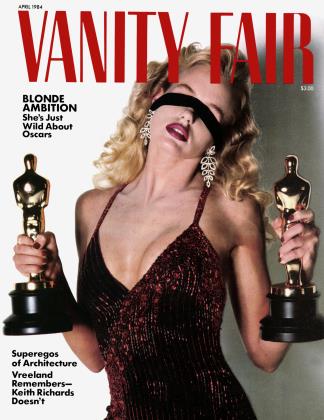Sign In to Your Account
Subscribers have complete access to the archive.
Sign In Not a Subscriber?Join NowArt
IN DEFENSE OF ARTISTIC FASHION
ONCE upon a time in the world of art, there was a conservative position which held out for supposedly timeless values, and a radical position which stood up for the supposedly new. That time lasted from roughly the middle of the nineteenth century until roughly a decade ago, when the “death” of the avant-garde as the cutting edge of art culture was widely noted. Less remarked was the simultaneous, symbiotic “death” (we are so melodramatic about these things!) of coherent artistic conservatism, principled foot-dragging in the face of change.
What had happened was a vast absorption of art culture into a culture of bureaucratic, corporate, and academic institutions. Conservatives and radicals did not disappear—from the neoconservative journal The New Criterion to the poststructuralist October, we retain a full spectrum—but in many formerly divisive respects, conservatives and radicals began to resemble one another. On both the right and left today there is substantial agreement about the issue, for instance, of “fashion.”
The current art fashion, loosely termed neo-expressionism, is international in scope, with strong German, Italian, and American contingents. It has attained stunning success with almost no help from the institutional culture, being largely a phenomenon of the market and of journalism. Its few critical supporters, like the movement itself, cannot be neatly classed as either conservative or radical. In institutional and ideological circles, the neo-expressionist wave is uniformly disdained for its dependence on commerce and publicity, its fashionability. Is “fashion” art’s new cutting edge? I think so.
What, exactly, is objectionable about fashion in art? (I will define such fashion as the widespread, temporary popularity of a style, idea, artist, or group of artists.) For conservatives, who idealize good breeding in all things (code word, “quality”), fashion represents the ungrounded, vulgar presumption of the arriviste. For radicals, categorically opposed to existing structures (the satanic “status quo”), it is an engineered illusion of change, an opiate of the people. In common usage, “fashion” is a uniquely powerful pejorative because it piggybacks negative connotations from both ideological tendencies. Contempt for the fashionable is such a united front of our day that a phrase like “Artist X defies the dictates of fashion” will register universally as high praise.
Enmity to artistic and intellectual fashion actually requires no rationale, because it is fueled by potent fears: fears of freedom and of the future. The freest of all our arenas for styles and ideas, fashion is a realm of seriously playful competition which scorns certainty and security in favor of whim, infatuation, wit, and fantasy—all the most volatile forms of imagination and desire. So much liberty intimidates us by shaming our limitations. Fashion also celebrates, by bracketing, the continuous arrival of the future—at a time when thoughts of the future fill most of the human race with dread. The sensation of momentum in time reminds us of death’s encroachment.
Fashion spotlights the characteristic, unprecedented, unrepeatable aspects and attitudes of an age. It is the sphere of immediate, evanescent meanings. It is also the essential frame of civilized discourse. Without it we could not agree on what to talk about. Happily, we are never without it, whatever we may imagine. Antifashion rhetoric is itself a contemporary fashion—an unusually vehement and important one. It is important because it resurrects, at least briefly, the kind of broadly based resistance to change, the reflexive antagonism to the new, that is prerequisite for an avant-garde.
—Peter Schjeldahl
 View Full Issue
View Full Issue


















Subscribers have complete access to the archive.
Sign In Not a Subscriber?Join Now